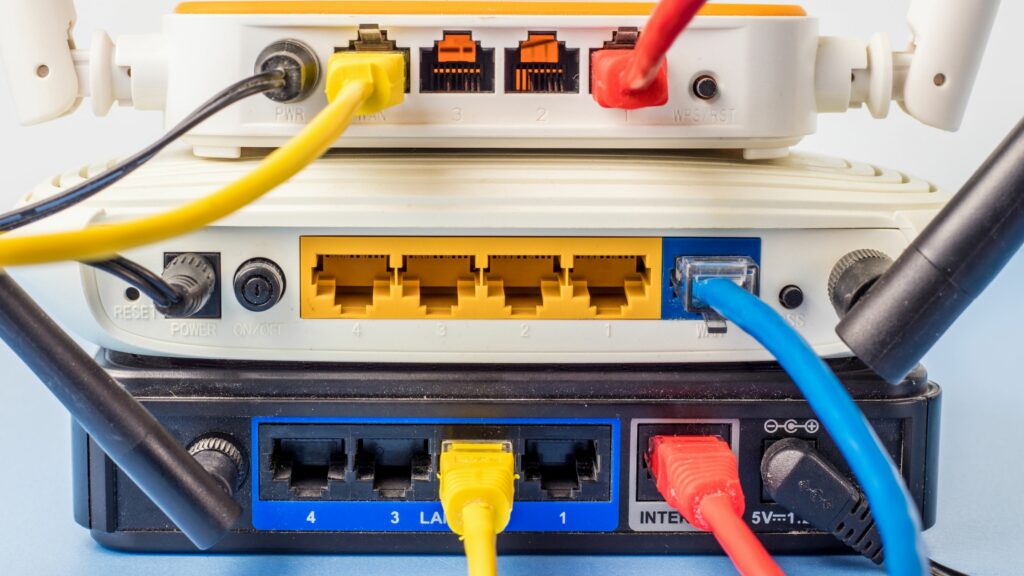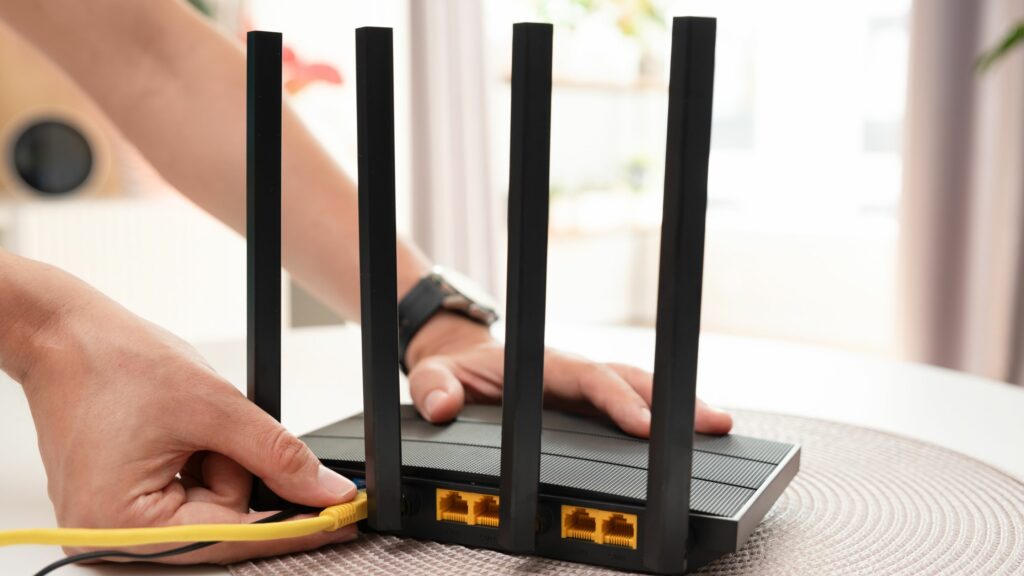Are you frustrated with the unreliable and costly traditional phone services for your business communication needs? Many small to medium enterprises face the burden of expensive monthly bills and inflexible systems that can’t keep up with modern demands.
Imagine missing out on potential sales because your phone service randomly drops calls or fails during peak hours.
Or the constant struggle of adding new lines and features that come with hefty service fees and complicated contracts. These issues aren’t just annoying—they’re costing you real money and opportunities every day.
These adapters transform your internet connection into a powerful telephony solution. Enjoy crystal-clear voice quality, seamless scalability for adding lines without hidden fees, and modern features like voicemail-to-email, call forwarding, and multi-device integration.
What is a VoIP Adapter?

A Voice over Internet Protocol (VoIP) adapter, sometimes referred to as an analog telephone adapter (ATA), is a device that acts as a bridge between traditional analog telephony devices and a digital network. These adapters allow users to connect their regular phones, fax machines, or other analog telephony equipment to a VoIP network for digital communication. VoIP adapters come in different forms and sizes, but their fundamental function is to convert analog voice signals into digital data that can be transmitted over the internet. By connecting to an ITSP (Internet Telephony Service Provider), these adapters facilitate the seamless integration of analog devices into VoIP systems, ensuring efficient and modern communication.
Definition and Overview
Understanding VoIP adapters is centered on recognising their role in facilitating voice communications over internet connections. These adapters are designed to link analog devices to a digital network, typically using an Ethernet connection or a built-in router for network access. With various provisioning options, VoIP adapters are configured to work with different VoIP services and SIP profiles, ensuring compatibility and smooth operation across VoIP networks.
The use of a VoIP telephone adapter typically delivers a wide range of advanced features that extend beyond standard voice calls. For example, users can often enjoy functionalities such as 3-way voice conferencing, caller ID management, and Web-based management of their settings. This flexibility means that both residential users and businesses can tailor their VoIP setup according to their specific needs while capitalising on the potential savings of VoIP compared to traditional telephony services.
Importance of VoIP Adapters in Communication
The significance of VoIP adapters cannot be overstated in today’s communication landscape. The shift from traditional phone lines to internet-based calling has not only introduced cost-efficiency but also enhanced the range of communication features available to users. With a VoIP adapter, old analog equipment like telephone handsets and fax machines that would otherwise be obsolete can gain a new lease on life by connecting to VoIP services, enabling continued utility in a digitised environment.
Additionally, as businesses and individuals increasingly adopt VoIP technology for its scalability and cost-saving potential, the necessity for reliable VoIP adapters grows accordingly. Using these devices, organisations can maintain their existing analog telephony equipment, thus saving on initial capital outlay for new hardware. VoIP adapters function as crucial components in this transitional phase, easing the move from conventional analog systems to future-proof digital communication networks.
Types of VoIP Adapters
VoIP adapters come in a variety of types, each designed to cater to different needs within VoIP networks. Here are the main types of VoIP adapters you might encounter:
Analog Telephone Adapter (ATA)
The Analog Telephone Adapter (ATA) is the most common type of VoIP adapter used to connect a standard analogue phone to a digital VoIP network. It typically has at least one analog interface to plug in a conventional phone and an Ethernet port to connect to your internet network. Some ATAs have multiple phone ports, allowing users to connect more than one phone. They are generally easy to install and configure, and they convert the analog signal from your phone into digital data that can be transmitted over the internet.
VoIP Phone Adapter
Separate from ATAs, VoIP phone adapters are devices that are often designed with more advanced features specifically for VoIP phones, which are already digital. These may include multiple Ethernet ports for network pass-through, support for more complex SIP profiles, or advanced voice and fax protocols. They enable users to harness the full potential of VoIP service with high-quality voice transmission and additional functionality.

VoIP Gateway
A VoIP gateway is a more robust solution that is used in both residential and enterprise settings. It serves as an intermediary that can connect multiple analog lines to a VoIP network or bridge VoIP calls to traditional PSTN lines. Gateways often come with additional features like call routing, voice compression, and support for numerous simultaneous calls. They are ideal for businesses that need to upgrade to VoIP while still maintaining a substantial volume of analog telephony equipment.
Each type of adapter offers unique benefits and features. The choice of which to use would typically depend on the scale of the VoIP implementation, the types of devices being connected, and the specific requirements of the communication setup. When selecting a VoIP adapter, it is important to consider compatibility with your existing hardware, the features and capabilities you require, and the level of scalability you anticipate needing in the future.
Benefits of VoIP Adapters
VoIP adapters are pivotal in modern communication systems, offering a wide range of benefits to both personal and enterprise users. These devices serve as bridges between traditional telephony and the increasingly prevalent digital network. By enabling the use of conventional analog devices over a VoIP network, adapters ensure that individuals and businesses can transition to VoIP services without the need for immediate investment in new equipment. This flexibility extends the life of existing telephony hardware, combining the reliability of old with the efficiency of the new.
Cost Savings of VoIP Adapters
Implementing VoIP adapters can lead to significant cost savings. A VoIP setup often eliminates costly PSTN lines, reducing line rental and expensive long-distance call charges. For individuals and businesses, this means enjoying the savings of VoIP with minimal setup costs. VoIP service providers often offer competitive rates and packages that can further reduce overheads. VoIP adapters are a one-time investment that can translate to enduring savings by sidestepping the need for entirely new VoIP-based hardware.
Flexibility and Mobility
VoIP adapters are acclaimed for the flexibility and mobility they offer. Users aren’t tied to a physical location; they can move their adapters and compatible equipment to new locations with ease, as long as there’s an internet connection. This is particularly beneficial for remote workers and businesses with mobile teams or those that need to relocate often. By simply plugging the adapter into an Ethernet connection, users can have their phone service set up instantly, maintaining business continuity and personal communications without disruption.
Advanced Features and Functionality
With the advent of VoIP phone adapters and gateways, users are not only presented with standard call functionalities but also a suite of advanced features. These may include 3-way voice conferencing, caller id services, voice mail, and call forwarding, which were traditionally offered at premium costs by analog systems. VoIP adapters can support complex SIP profiles and may also come with built-in routers, offering sophisticated handling of voice, video, and data transmission for a comprehensive communication experience.
Integration with Analog Equipment
One of the key strengths of VoIP adapters is their ability to integrate seamlessly with existing analog telephony equipment. This means businesses and individuals can continue to use their current telephones, fax machines, and analog PBX systems while reaping the benefits of digital VoIP services. This backward compatibility eliminates immediate outlays for new digital equipment, making the transition to a VoIP network cost-effective and less disruptive to daily operations. Additionally, many VoIP adapters come with provisioning options and web-based management, simplifying the configuration and maintenance of analog equipment on a modern VoIP network.
How VoIP Adapters Work
VoIP adapters, also known as Analog Telephone Adapters (ATA), are ingenious devices that convert analog voice signals into digital packets for transmission over an IP network. At a fundamental level, the adapter connects to a traditional analog phone on one end and to an Ethernet router on the other. When you make a call, the adapter takes the analog signal from your phone, digitises it, and sends it as data over the internet to the recipient, where the process is then reversed. This simple yet powerful functionality is what allows the use of older analog telephony equipment on modern VoIP networks.
Understanding VoIP Networks
VoIP networks are at the heart of modern communication, enabling voice, and sometimes video, data to travel via the internet. Unlike the traditional Public Switched Telephone Network (PSTN), VoIP transmits voice data in packets using the Internet Protocol (IP)—the same method used to send and receive all other types of data over the internet. This digital format allows for more efficient and flexible communication services. By accessing a broadband internet connection, users can make and receive calls from anywhere, breaking down the geographic limitations inherent to conventional phone lines.
SIP Profiles and Provisioning Options
Session Initiation Protocol (SIP) profiles contain the settings that VoIP adapters use to establish communication with VoIP service providers. A SIP profile includes information like the user’s account details, server registration settings, and authentication requirements. These profiles enable devices to initiate and manage VoIP sessions, effectively making and receiving calls.
Provisioning options refer to the methods used to configure VoIP adapters and devices remotely. Providers often offer various provisioning methods, such as:
- Manual configuration via a web interface
- Automated provisioning using a configuration file hosted on a server
- Advanced centralised management systems for large-scale deployments
These options ensure that users can customise their VoIP experience to match their precise needs and preferences.
Choosing the Right VoIP Adapter
When selecting a VoIP adapter, it’s crucial to consider your specific requirements and setup. Look for an adapter that supports the number of phone lines you’ll be using, whether that’s a single line for home use or multiple lines for a small business. The type of interfaces provided by the adapter is another consideration; some come equipped with built-in routers, which can be beneficial for managing network traffic. Analyze what advanced features are necessary for your needs, such as 3-way voice conferencing or fax machine compatibility. Additionally, not all VoIP adapters are created equal in terms of build quality and reliability, so reading customer feedback and reviews could guide you towards devices that have proven their worth in real-world applications. Furthermore, if you plan to use a VoIP virtual number, ensure that the adapter you choose is compatible and can seamlessly integrate with your virtual number setup.

Compatibility with Analog Devices
VoIP adapters bridge the gap between traditional analog equipment and digital VoIP networks. When assessing compatibility, verify that the adapter supports the analog devices you want to continue using, such as analogue phones, fax machines, or any other analog telephony equipment. An ideal VoIP adapter should provide a seamless analog interface that translates analog signals without latency or quality loss. Furthermore, for environments where power outages are a concern, make sure the VoIP adapter includes failover options that can redirect calls to an analog line during such events. This ensures continuous operation and accessibility.
Considerations for VoIP Service Providers
Choosing the right VoIP adapter also entails making sure it’s compatible with your VoIP service provider. Each provider may use different SIP profiles and protocols, so it’s necessary to confirm that the adapter can be configured to work with your chosen provider’s network. This is important both for making VoIP calls and for utilising the full range of services offered. Trustworthy VoIP service providers will supply clear information on the types of adapters that best suit their networks. In selecting an adapter that supports various provisioning options, such as web-based management, you can also look forward to a more streamlined setup and easier ongoing management.
Range of Caller Features and Services
VoIP adapters offer a wide range of caller features and services that can enhance your telecommunication experience. When choosing an adapter, you’ll want to consider which features are important to you. These may include call forwarding, caller ID, voicemail, speed dialing, and do not disturb settings, amongst others. Some adapters also support advanced features like 3-way voice conferencing, enabling collaborative calls without the need for additional hardware. The broad span of capabilities available means that customers can essentially tailor their communication systems to their particular preferences, factoring in the nature and volume of calls they expect to manage.
Setting Up VoIP Adapters
Setting up a VoIP adapter is relatively straightforward and can seamlessly integrate your analog devices into a digital network. To start, ensure that you have an active internet connection, as VoIP services are dependent on it. Next, connect your VoIP adapter to your network via an Ethernet cable. Most adapters will have an Ethernet port labeled “Internet” or “WAN.” Once connected to the network, you also need to link your telephone to the adapter. This usually involves plugging your phone’s cord into the correct port on the adapter, often labeled “Phone 1” or “FXS.” Power up the adapter and allow it a few minutes to initialise and connect to your VoIP service provider.

Before diving into calls, you’ll need to configure the VoIP adapter settings. Access the adapter’s web-based management portal using a browser on a computer connected to the same network. Enter the login details provided with your device or in its manual. Here, you can enter the SIP credentials given by your VoIP service provider and adjust any necessary parameters, such as dial plan settings or audio codecs. Once configured, you can usually test the connection directly from the management interface. Proper setup will ensure that your calls are both clear and reliable.
Connecting Analog Devices to VoIP Adapters
To integrate your analog devices like phones or fax machines with a VoIP adapter, physical connections are a must. Start by identifying the appropriate ports on your VoIP adapter; these are commonly marked as “FXS” for connecting analog telephone devices. Using a standard RJ-11 phone cable, connect your device to the adapter. If the adapter supports multiple analog devices, ensure they are connected to their respective ports, frequently indicated by “Phone 1”, “Phone 2”, etc.
Once connected, power on your analog device. It should now be part of the digital VoIP network and can send and receive calls over the internet. If the adapter has multiple FXS ports, and you are using more than one analog device, be sure to check that each device operates correctly and without interference from the others. If you plan to use a fax machine over VoIP (a process known as ‘FoIP’), ensure the adapter supports T.38 protocol or a similar fax-over-IP solution to facilitate reliable fax transmissions.
Configuring VoIP Adapters for Analog Telephony Equipment
After connecting your analog telephony equipment to the VoIP adapter, you’ll need to configure the device settings to ensure clear communication. This customisation can typically be done through a web-based management platform. You’ll want to configure Network settings, such as Dynamic Host Configuration Protocol (DHCP) for automatic IP addressing or assign a Static IP address if necessary. Under the VoIP settings, input the SIP credentials provided by your VoIP service provider.
Configure the codecs used for audio to match those supported by your provider for the best quality. Additionally, tone settings, including the dial tone and ring patterns, can often be configured to your preferences or the standards of your locality. If your analog equipment includes features like call waiting, voicemail, or caller ID, ensure those are properly set up within the adapter’s configuration to work correctly with your service.
Security and Firewall Considerations
When integrating VoIP adapters into your network, security should be a top priority. Configuring firewalls correctly is critical to both protect your network and ensure that VoIP traffic is unimpeded. Within your network firewall settings, prioritise VoIP traffic using Quality of Service (QoS) to maintain call quality during high-bandwidth activities. Open or forward the necessary ports for your VoIP service; your provider will specify which ones are required.
Security protocols like SIP ALG (Application Layer Gateway) or VPN (Virtual Private Network) might need to be enabled or disabled depending on the adapter and service requirements. Use strong, unique passwords for both the VoIP service and the adapter’s management interface to prevent unauthorised access. Keep firmware updated to the latest version as these updates often patch known security vulnerabilities. Always ensure that communication is encrypted, usually through SRTP (Secure Real-Time Transport Protocol) or TLS (Transport Layer Security), to protect your calls from eavesdropping or data breaches.
Troubleshooting and Customer Support

When it comes to VoIP adapters, even with the best setup, you may occasionally encounter issues that interfere with your service quality or connectivity. Troubleshooting such issues is an integral part of maintaining a reliable digital communication system. Common problems can often be remedied through a series of basic steps such as:
- Restarting your VoIP adapter to refresh the connection.
- Checking physical connections (cables and ports) for any loose connections or damage.
- Verifying network settings are correctly configured.
- Ensuring the adapter’s firmware is up-to-date.
- Testing the internet connection to confirm that the issue isn’t stemming from network problems.
Moreover, most VoIP adapter providers offer comprehensive support resources such as user manuals, frequently asked questions (FAQs), and online troubleshooting guides to assist customers in resolving common issues. For more complex situations, customer support lines or live chat services are available to provide professional assistance.
Common Issues with VoIP Adapters
VoIP adapters are generally reliable, but sometimes users may encounter issues. Common problems include:
- Poor Call Quality: This could be due to bandwidth limitations, incorrect Quality of Service (QoS) settings, or problems with the audio codecs.
- No Dial Tone: This may be a result of incorrect physical connections or settings that need to be reconfigured.
- Issues with Fax Transmission: Sending faxes over VoIP can be tricky, and ensuring the adapter is set up to support T.38 protocol can help alleviate issues.
- Adapter Not Connecting to Service Provider: This can occur if SIP credentials are misconfigured or if the adapter is not properly authorised with the provider.
- Dropped Calls: Dropped calls are often a sign of network instability or configuration errors with the session initiation protocols.
Creating a checklist of these common problems and their potential solutions can be a first step in the troubleshooting process.
Customer Feedback and Support Services
VoIP services providers understand the importance of user feedback for the ongoing refinement of their products and services. Many providers encourage customers to leave feedback on their experiences, which can be found on:
Online review platforms
Customer testimonial sections on their websites
Customer surveys after resolving support issues
In turn, these providers offer support services to address any concerns or issues that arise, responding to feedback with:
Guides and resources tailored to the most common issues faced by users.
Updates and improvements to hardware and software, often influenced by user suggestions.
This cycle of feedback and support services is pivotal not only for improving customer satisfaction but also for advancing the technology and service offerings.
Assistance from Customer Services Representatives
When issues surpass the complexity of self-help resources, customer services representatives play a pivotal role. They can:
Provide step-by-step guidance via phone, email, or live chat
Offer advanced troubleshooting techniques beyond the scope of the user manuals
Schedule technician appointments if an on-site inspection or repair is necessary
Facilitate warranty claims or replacements for faulty hardware.
Frequently Asked Questions
What is a VoIP Adapter?
A VoIP (Voice over Internet Protocol) adapter, or analog telephone adapter (ATA), converts analog voice signals from traditional phone devices into digital data that can be transmitted over the internet. This enables you to use your regular phones or fax machines on a modern VoIP network.
How do VoIP Adapters work?
VoIP adapters connect your analog telephony devices to a digital network via an Ethernet connection. When you make a call, the adapter converts the analog signal into digital packets, sends them across the internet, and then converts them back at the receiving end.
What are the benefits of using a VoIP Adapter?
VoIP adapters allow you to continue using existing analog telephony equipment with new digital VoIP services, reducing the need for immediate investment in new technology. They also offer cost savings by eliminating the need for traditional phone lines and expensive call charges, plus they bring advanced features like call forwarding and voicemail-to-email.
How do I choose the right VoIP Adapter?
Select a VoIP adapter based on the number of phone lines you need, the types of devices you want to connect, and the specific features you require, such as support for fax machines or advanced call routing. Ensure compatibility with your VoIP service provider and check for user reviews on reliability and performance.
How do I set up a VoIP Adapter?
Connect your VoIP adapter to your internet network and analog phone. Configure it using the web-based management interface where you’ll enter settings provided by your VoIP service provider, such as SIP credentials and dial plan settings. Once configured, your phone should be ready to make and receive calls over the internet.
What are the common issues with VoIP Adapters and how can I troubleshoot them?
Common issues include poor call quality, no dial tone, problems with fax transmission, difficulty connecting to the service provider, and dropped calls. Troubleshooting steps involve checking connections, ensuring correct configuration settings, verifying network stability, and updating the adapter’s firmware. If problems persist, contacting customer support is advisable.
Can VoIP Adapters work with any type of internet connection?
Yes, VoIP adapters are designed to work with any type of broadband internet connection. However, the quality and reliability of VoIP calls can be affected by the speed and stability of your internet connection.
These FAQs should help clarify the basics of VoIP adapters and assist prospective buyers in making informed decisions about incorporating this technology into their communications setup.
Final Words
VoIP adapters represent a transformative bridge between traditional telephony and the vast possibilities of digital communication networks. By integrating these adapters, businesses and individual users can revitalise their existing analog equipment, merging reliability with the advanced features of modern VoIP technology. The cost savings, enhanced flexibility, and broad spectrum of functionalities offered by VoIP adapters make them an invaluable asset for anyone looking to upgrade their communication systems without the burden of significant initial investments.
Moreover, the simplicity of setting up a VoIP adapter, coupled with the extensive support and troubleshooting guides available, ensures that even those new to VoIP can make a smooth transition. Whether you are a small business owner aiming to optimise operational costs or a home user interested in improving your communication setup, VoIP adapters provide a practical and efficient solution. We invite you to share your thoughts and experiences with VoIP adapters in the comments below. Have you switched to VoIP recently, or are you considering it? What challenges and benefits have you encountered? Let’s discuss how this technology is shaping the future of communication.


